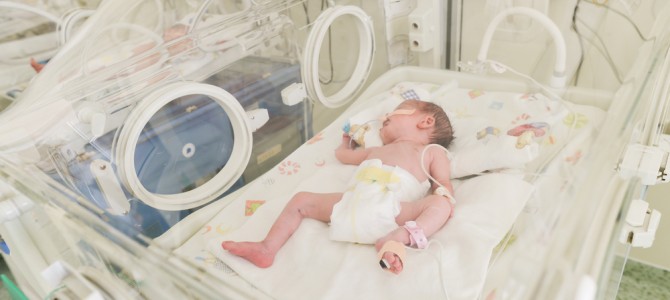
Thanks to advancements in science, a premature baby born today has a higher likelihood of survival than if he or she were born at any other time.
Look at Emlyn Jackson. Although she only weighed 1.56 pounds when she was born 13 weeks early on April 23, she is doing well thanks to advancement in medicine, along with her family’s support and fighting spirit of course. Emlyn might have to be in the NICU until mid-July, when she was supposed to be born, but she has already undergone a gamut of tests and procedures, from blood transfusions to brain scans, that are keeping her stable and progressing toward wellness.
Her dad, Scott, characterized little Emlyn as a “hardass survivor” in a Twitter update, noting she is responding well to treatment.
https://twitter.com/NotScottInSC/status/989070759707529216
For perspective, here’s a photo of her tiny foot:
https://twitter.com/NotScottInSC/status/989910970125471745
Emlyn’s story demonstrates something pro-life advocates have long believed: Science is pro-life.
“She would not have lived more than a few minutes without a ventilator after she was first born,” Scott told me in an email. “When she was about 15 hours old, they discovered that she had a pulmonary hemorrhage and kept her alive with CPR and epinephrine (adrenaline). Without the knowledge of her doctors, nurses, technicians, and the technology they use, she would not be alive now.”
Premature Babies Can Thrive
Unlike a few decades ago, premature babies can now survive and thrive, even when they’re born at an incredibly young gestational age. Last year the journal Pediatrics published the case report about a miracle baby girl born at just 21 weeks and four days gestation, and weighing in at a mere fifteen ounces. The report said the baby, whose parents requested her name and current photos be withheld for privacy reasons, “may be the most premature known survivor to date.”
Her mom knew the survival rate, that she could find online anyway, was literally zero. “There were stories of 22-weekers, 23-weekers, but nothing about 21-weekers. So I knew that there was little to no survival or viability at 21 weeks,” she told CNN.
Owen Green’s story is similar in that he and his family also fought for survival and he too, is also growing and seems to be on par with his peers developmentally. Wired reports:
Owen was delivered by emergency C-section in November at about 24 weeks gestation. Schneider held Green’s shoulders while the delivery team worked on the other side of a raised curtain. They caught a glimpse of their tiny son, wrapped in plastic to trap his body heat, before he was wheeled away in an incubator. At 1.4 pounds, Baby Boy Green was admitted to the neonatal intensive care unit at BC Women’s Hospital. He had a 60 percent chance of survival.
Science, both in terms of technology and in understanding the human component of care as it relates to neonatology, has advanced so much, it has given babies–and the parents desperate to keep them alive–a chance at life they likely would not have had without expert tools and care.
Science Backs The Assertion That Life Begins At Conception
The miracle births of these babies show what science has supported for so long: that all babies are babies at conception. They only need time and in this case, extraordinary medical care, to develop into a talking toddler. Liberals have to turn a blind eye to science in order to make the case that abortion is ethical and legal. While the progressive left and much of the mainstream media might pretend to be unaware of when life begins, the science on this remains firm.
In an article published just this last month, the American College of Pediatricians said, “The predominance of human biological research confirms that human life begins at conception — fertilization. At fertilization, the human being emerges as a whole, genetically distinct, individuated zygotic living human organism, a member of the species Homo sapiens, needing only the proper environment in order to grow and develop.”
Dr. Joseph DeCook, executive director of the American Association of Pro-life Obstetricians and Gynecologists, a group of about 2,500 members, said an embryo is a living human being at the moment of fertilization. “There’s no question at all when human life begins,” Cook told CNN.
While pro-choice advocates spend an inordinate amount of time arguing their position claiming no one can know when life begins, or that scientists are unsure, an overwhelming number of the scientific community — researchers, obstetricians, and scientists — are in fact quite sure.
How does the debate over when life begins relate to a story like this? After all, the baby was born, so she should at least deserve a shot at life, right? The argument over when life begins, combined with miracle stories like these, helps make an air-tight case for pro-life advocacy at all times. Whether born at 21 weeks, 30 weeks or 40 weeks, every baby can and should be resuscitated, labored over, and loved. You never know when a miracle will happen.
Scientific Advancements Support Neonatal Survival
Even as one side of ideological naysayers argue life can’t possibly begin at conception, doctors, scientists, and research fellows continue to press forward to develop tools and methods that will increase the chances of a baby’s survival, bolstered by this underlying presumption of when life begins. If anything, significant advances in neonatal medicine have enhanced this belief, not undermined it.
According to the World Health Organization, about 15 million babies are born before 37 weeks gestation and according to a recent report the March of Dimes, there has been a slight uptick in preterm births. However, a brief look at the history of neonatal care shows that science has continued to make great strides in increasing the survival rate of preterm babies fighting for their lives.
In the 1990s, the increase of technology to care for premature infants as well as an increase in professional knowledge about premature infants gave hope to babies who in previous decades may have been considered lost causes. Babies as young as 23 weeks gestational age and as small as 500 grams were successfully treated.
In the last several decades, advancements in neonatal care have significantly improved the chances for babies to survive outside their mother’s wombs. After a team of Rice bioengineering students invented a low-cost bubble CPAP device, which helps infants breathe, a 2014 study found that indeed, the breathing system “demonstrated that the device increased the survival rate of newborns with severe respiratory illness from 44 percent to 71 percent.”
In 2012, Florida State University and Powers Device Technologies Inc. donated a groundbreaking invention to a local hospital NICU. It was a Pacifier Activated Lullaby (PAL) — “a medical device which uses musical lullabies to help premature babies overcome one of their greatest growth hurdles — learning how to suck.”
The World Economic Forum ranks Bruno Castillón Lévano among the 11 best inventors in Latin America, with his incredible invention: The neonatal artificial bubble. “His knowledge allowed him to invent and patent — even in the United States — a cutting-edge incubator that saves the lives of premature babies at high risk,” the forum writes.
These are just a few of the specific tools available now.
One of the more incredible changes in the last ten years is the “kangaroo” method of holding a baby skin to skin following premature birth was developed in the 1970’s, but only started to be implemented in an integrated way in hospitals recently. Whereas usually both mom and baby are separated and cared for immediately following what is often a stressful birth, some hospitals — like the one baby Green was born at in Canada — allow for integrated mother and baby care in a private NICU room. Changes like these are making it so premature babies survive outside the NICU and thrive in the real world.
Science continues to show the pro-life movement is on the right side — and it might be why the movement appears to be winning the culture war.









